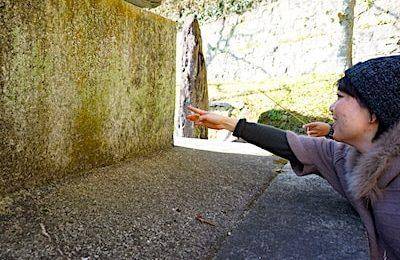How to Onsen
Learn how to onsen in Japan. Read on for Japanese onsen etiquette, onsen rules, and onsen Do’s and Don’ts. A must-read article for anyone planning to onsen in Japan.
If you want to know what onsen is or what does onsen mean you better skip to this article first. Then head right back when you are ready to strip off and take the plunge.

One of Kyushu's natural hot-spring spas
How to use onsen
Kyushu has some of the best onsen in Japan. You have to try one at least one onsen spa while you are here. Here are a few simple onsen tips (we can call them ‘onsen rules‘ I guess) to help you enjoy your experience:
Remember your shoes
Making payment
How much does an onsen cost?
Onsen and Tattoo
Don’t go into an onsen with a tattoo. Usually, but not always, tattoo are a big no-no in onsen in Japan.If you have a small tattoo you can cover it with a sticking plaster. You can also buy specialist plaster to cover tattoo here . There are some tattoo friendly onsen but you need to check first.
Tattoo and Family Bath
Onsen towel

Blue for boys
Red Alert: boys and girls
Don’t blunder into the changing room of the opposite sex. Especially guys wandering into female changing rooms will cause an uproar. Lookout for the Japanese character 男 for male and 女 for female. To make it even easier you can just remember the blue curtain hanging at the entrance is for male and red for female. Warning: some onsen switch baths morning and evening or on alternate days. So just because the one on the left was male last time you bathed doesn’t mean it’s for male this time. Always check for 男 (blue) for male and 女 (red) for female. I repeated that because you really don’t want to screw this up.

Red for girls
In the changing room
Strip naked and put your clothes in the locker (if there is one) or on a basket on the shelf. Yes, you have to strip naked. You can’t use swimsuit or underwear. Use the small towel to casually hang in front of you.
Take off your watch and any jewellery and leave it with your stuff in the changing room. They can get get damaged by the natural chemicals in the onsen water.
Tip: There will be a toilet in the changing room but usually not in the bathing area. Use the toilet before you start bathing so you don’t have to come inside dripping wet to take a pee.
Don’t take a phone, a camera, a glass bottle or a book into the bathing area. You can take a plastic bottle with drink though there is usually a drinking water fountain.
Lots of people take their own soap and shampoo and shaving stuff in a small basket. I never bother because soap and shampoo is provided and I’m not brand-fussy.
If you want to shave or clean your teeth bring these items with you. You don’t usually find them inside (though you can buy them at the entrance). The only place you commonly see them inside is at hot baths in capsule hotels.
In the bathing area
- Wash, soap and rinse yourself completely (and wash your hair) before starting bathing.
- Especially in winter, some people (like me) just get a quick rinse in the washing area before bathing. Then after getting nicely warmed up in the onsen bath get out again for the full monty wash, soap and rinse, before getting back in for another bathing session.
What about your specs?
In the onsen bath
Don’t jump, dive, or splash around. Don’t move quickly causing waves. It’s a relaxing pool, right? Not a swimming pool.
Don’t put your hair or towel in the water. Less polite people than me and you sometimes do but we don’t want to behave like them do we? You can leave your towel at the edge of the pool somewhere or be super-unfashionable and keep it on your head while bathing. That’s what all the old guys do anyway.
Based on my previous experience don’t stay in really hot water too long. If you stand up too quickly you can get dizzy and topple over Pro Tip: Avoid dizziness by splashing yourself with cold water before getting into the bath.
If it’s an outside bath, or if you come from an outside bath to an indoor one, use the water from the bath to rinse your feet before getting in. You don’t want to bring bits of twig or mud into the pool do you?
If you come from the sauna rinse yourself off (no need to soap again) before getting in the bath. Who wants to bathe in your sweat? Author grumble: (nothing to do with onsen) loads of people seem to forget this in my gym when they go from the sauna into the jacuzzi. I think it’s gross.
Finally, dry yourself a bit with your towel before going into the changing room so you don’t drip all over the floor.
Drinking in onsen
Don’t get drunk. There was a craze a few years ago of celebrities drinking sake and then having heart attacks in onsen. It’s pretty slippy too. In many onsen drinking alcohol is forbidden. I have to admit in my drinking days I’d often sneak a can of ice-cold beer in (just one). You shouldn’t though, so do as I say not as I did.
What to do in an onsen (how to enjoy)
Move around from bath to bath
I’ll start with a quick wash down. You’ll remember that we never bathe dirty, right? Then I’ll have a long soak in the main bath. I mean, I’ll stay in there as long as I can stand it until I get really hot. I like to feel the day’s stresses and strains melting away. I also like to think of myself as healing. Don’t forget, onsen waters are healing waters. They come from deep underground and are rich in minerals. The Japanese have known for hundreds of years the healing properties of different kinds of onsen. You probably won’t be able to understand it (I don’t) but on the wall of most onsen you will find a sign saying which specific minerals those waters are rich with and what they are best at curing. I’ve had dodgy knees for years and definitely feel a good soak does me good.
How to bathe in the icy pool
The outdoor bath (rotenburo)
I’ve left the best bit until last. At least it’s the best bit for me. There’s nothing I like better than enjoying an outdoor bath ( rotenburo ). Especially in winter I love to sit at the edge of the pool until I’m starting to get freezing cold and then lower myself right down up to my neck into the toasty warm waters. Then repeat. Heavenly. If you can have a view of snow-capped peaks it’s just about as good as it gets.
The electric bath (denkiburo)
The end bit
… Zzzzz
Comments (2)
Hi Toby,
Most onsen still don’t allow people with tattoo. The only way to know is contact them and ask in advance, or at least when you arrive. If we plan your itinerary we’ll do that for you – that’s why we ask all clients if they have tattoo at the start of the planning process. Another idea is choose an onsen with ‘family bath’ so you, your partner and/or kids can bathe privately behind locked doors. Hope this helps.
More Kyushu info and ideas

Kyushu Travel
Essential research for visiting Kyushu - complete list of best Kyushu travel spots

Kyushu Road Trip: Takeo Onsen and Ureshino
Blog and photos of tea and onsen destinations off the beaten path.

Kyushu Cherry Blossom Dates
Kyushu Cherry Blossom Dates 2025: latest updated 'sakura' information

